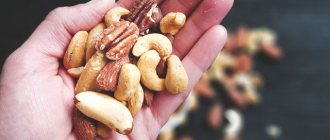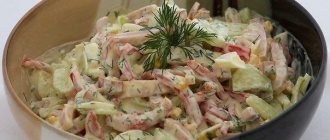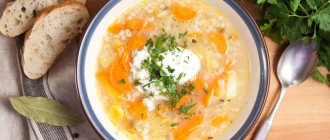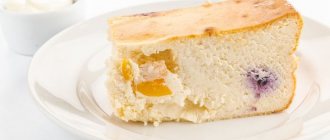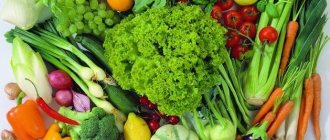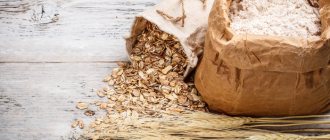- September 7, 2018
- Diets for health
- Lukinova Natalya
It's no secret that in recent years, gluten-free diet recipes made from affordable products have become increasingly popular. Nowadays, an increasing number of people are either completely gluten intolerant or, for some reason, choose to eliminate gluten from their diet. It is believed that by giving up these foods, you can significantly improve your health and even lose weight, but initially this nutrition plan was developed solely according to medical criteria, and not as a newfangled trend. Most people do not even realize that they have gluten intolerance, and attribute their poor health to other reasons. That is why it is important to know when a gluten-free diet is prescribed according to indications, and when it is not required at all.
Necessity of diet
The now popular gluten-free diet, which many people use to lose weight, is intended specifically for patients with problems that require the exclusion of all products containing gluten. To the question of why a gluten-free diet is needed, there is only one answer - for the prevention and treatment of diseases of the nervous or endocrine systems, as well as in the presence of a number of pathologies of the gastrointestinal tract. But this immediately leads to an important question: why exactly is gluten so dangerous, since it is found in all baked goods, beer and pasta? Gluten is now used so widely that it is simply impossible to cover the entire range of its uses. This is why compiling the correct list of products on a gluten-free diet is so important, because this is what a person’s quality of life and health depend on.
Gluten-free diet - pros and cons
Like any diet, gluten-free has its advantages and disadvantages, as evidenced by numerous reviews from early testers and differences in professional opinions.
The advantages include:
- cleansing the body of toxins;
- rapid weight loss;
- free menu;
- wide range of products;
- lack of strict control over portion sizes;
- skin cleansing;
- improvement of well-being.
Among the disadvantages are:
- the need for constant replenishment of fiber, iron and vitamin B;
- difficulties in constantly monitoring the composition of products;
- limited range of industrial gluten-free products, which increases the time spent on food preparation;
- complete exclusion of flour products and sweets.
A little about gluten
Before moving on to determining the permitted list of foods on a gluten-free diet, you should determine what gluten is and what danger it can pose.
So, gluten (gluten) is a protein found in the seeds of cereal crops such as wheat, rye, barley and many others. This substance received its Russian name from the word “glue”, since when mixed with water, flour acquires a sticky state. Gluten must be contained in flour, since it is this that provides baked goods with that pleasant and soft taste and texture that are so popular among the people.
Unfortunately, some people may have an unpleasant reaction to this substance. The reason to use a list of gluten-free diet products may be an allergy to wheat, hypersensitivity to flour components, or even advanced celiac disease. That is why this diet is considered therapeutic, since its main purpose is to help prevent the development of symptoms of these diseases and even prevent complications.
Doctors directly say that this diet is not one that a healthy person should use to lose weight, despite the fact that it is quite possible to get rid of several kilograms of excess weight by giving up flour. It’s just that this technique can lead to the body being deprived of some essential substances, so you should first consult with a nutritionist.
Symptoms of celiac disease
Celiac disease is a hereditary disease. According to statistics, approximately one person out of 130 suffers from it. No more than five percent of patients are aware of this.
Gluten intolerance means that when consuming foods containing it, the intestinal mucosa is injured and atrophies over time. As a result, the passage of food through the gastrointestinal tract and its normal absorption become almost impossible.
These patients have weak immunity, are prone to depression, and infertility. They have increased or, conversely, decreased body weight, and often experience pain in the joints or numbness of the fingers. In advanced cases, gastrointestinal carcinoma may form.
Diet features
On a gluten-free diet, the list of foods allowed for children and adults is quite extensive, so the menu must be compiled based on a number of special principles in order to achieve significant results. Complete exclusion of gluten from the diet for the first time may be associated with quite strong changes in the body, and therefore a person needs to get used to the new diet for some time. However, despite this, it is quite possible to get used to it, since there are many delicious foods with which you can diversify your diet.
In the West, a gluten-free diet is often prescribed to pregnant women, as it is considered an excellent opportunity for the mother to prevent the risk of diabetes in her children. A gluten-free diet for nursing mothers is prescribed only if the child has a gluten intolerance, to prevent the child's condition from worsening.
Who needs it and in what cases?
Who needs a diet? First of all, people with celiac disease are an autoimmune disease. Such patients will have to avoid foods that contain gluten for the rest of their lives.
It is very difficult to achieve this, but with the help of this approach it is possible to get rid of most unpleasant symptoms (or at least significantly reduce their manifestations). These are cramps, gastrointestinal disorders, bloating, colic, vomiting, diarrhea, osteoporosis, iron deficiency anemia, joint pain, arthritis, eczema.
In addition, there are people who have an allergic reaction to gluten. They also have to exclude all foods containing this protein from their diet.
Not everyone needs to completely eliminate gluten-containing foods. But temporarily abstaining from their use will not hurt anyone. A gluten-free diet has proven itself well for autism, as well as schizophrenia and other mental disorders. However, no serious clinical studies have yet been conducted on this topic.
In addition to treating neuropsychiatric disorders, a gluten-free diet is good for improving the condition of those suffering from autoimmune hepatitis, asthma, Parkinson's disease, atherosclerosis, diabetes, vitiligo, psoriasis, obesity, myopathy, migraine and a number of other diseases.
Authorized Products
First of all, let's look at the list of products allowed on a gluten-free diet for children and adults. Ingredients that are completely gluten-free include:
- Absolutely all types of meat and poultry, regardless of their fat content.
- Any eggs - chicken, duck and quail.
- You should be careful when handling dairy products. You can freely eat cheese, regular milk and natural yoghurts. Avoid flavored dairy products as they may contain gluten. This answers the question of whether milk is ok on a gluten-free diet.
- All fruits and vegetables are also completely gluten-free.
- Porridges on a gluten-free diet can be made from buckwheat, millet, rice, quinoa and corn. Oats can only be used if there is a sign on it indicating the absence of this substance.
- There are gluten-free flours and starches that should be used to replace the standard ones - these are corn, potato, almond, and soy flour.
- Healthy fats - vegetable oils, nuts and seeds also do not contain gluten.
Greens, herbs and spices that will help make dishes tastier can also be used as desired. This diet excludes only beer from drinks, so the loss is not particularly great, because it is best to completely give up alcohol. As you can see, the list of foods allowed on a gluten-free diet is very extensive, so you can get many interesting recipes.
Prohibited Products
The list of prohibited foods on a gluten-free diet, which should never be eaten, is almost entirely based on a variety of cereals and grains. These include:
- Durum and sprouted wheat, rye, barley, bran.
- Matzo, semolina, couscous, oatmeal.
- Bread, pastries made from flour, cookies, and pasta should be excluded.
- When buying food in a store, you should look to see if it contains modified food starch, which is where gluten is hidden, so it is better not to buy a variety of snacks, chips, sausage, yoghurt, mayonnaise, dry broths and crab sticks.
- The only beverage that should not be included in the list of gluten-free diet products is beer.
You should be careful about hidden gluten, since it will still negatively affect the inflammatory processes that occur in the body, even if there is very little of it there.
Gluten-free diet - food list
A gluten-free diet is absolutely safe, but before starting the diet it is still better to consult a nutritionist or your doctor. Avoiding many foods and grains that contain gluten also means eliminating certain sources of vitamins and minerals from your daily diet.
Thus, people may experience severe nutritional deficiencies. There is a deficiency of calcium, iron, folic acid, fiber, vitamin B1 and vitamin B3. In this regard, “patients” are recommended to take vitamin supplements!
Prohibited Products
To treat celiac disease and prevent various complications, it is necessary to exclude the following foods from the diet:
- Wheat, barley, rye and oats,
- Confectionery and bars,
- Bread, buns, cookies, crackers and croutons,
- Ice cream,
- Muesli and oatmeal
- Pasta,
- Croutons,
- Various sauces, including soy sauce,
- Mayonnaise,
- Salad dressings,
- Crab sticks,
- Meat and seafood substitutes,
- French fries,
- Semi-finished products with spices and seasonings,
- Chips,
- Bouillon cubes and instant soups,
- Alcoholic drinks, including beer.
Necessary products or how to replace prohibited ones
Gluten-free foods can be eaten in any quantity. List of permitted products:
- Vegetables in any form (fresh, steamed, baked, stewed) and herbs. Legumes (beans, lentils, peas), cabbage (Brussels sprouts, cauliflower, cabbage), potatoes, radishes, cucumbers, carrots, tomatoes, white radish, turnips, soybeans, garlic, spinach, sorrel.
- Fruits and berries. Fresh apricots, pears, oranges, tangerines, avocados, peaches, nectarines, apples, cherries, cherries, grapes.
- Mushrooms.
- Nuts, dried fruits, flaxseed, sunflower.
- Vegetable oils. Soybean, olive, corn, sunflower.
- Cereals and gluten-free porridges. Buckwheat (kernel), corn grits, sorghum, millet, rice (white, brown, brown).
- Eggs (chicken, quail).
- Gluten-free flour and pasta made from it. These are amaranth, dietary corn and rice, nut, pumpkin, and lentil flours.
- Raw materials and seasonings. Starch (potato, corn), natural seasonings, grape vinegar.
- Dairy products. Milk, homemade sour cream and cream, kefir, yogurt, acidophilus, cottage cheese, butter from homemade cream without thickeners.
- Cheeses prepared independently (cheese, mozzarella).
- Meat products. Beef, veal, rabbit, turkey, chicken.
- Fish, seafood. Caviar (black, red), sprats in oil, any fish.
- Oils, fats. Oil (vegetable, butter)
- Beverages. Leaf tea (black, green, fruit), natural coffee made from whole beans.
- Home canning.
Menu for a gluten-free diet
Below, using a list of gluten-free diet products, a weekly menu will be presented, with which you can create your own diet, based on your personal taste preferences. Meals must be divided - preferably 4-5 meals every 3 hours. Using the available ingredients, you can prepare interesting vegetable, meat and cottage cheese dishes, and use various fruits and nuts instead of snacks.
Monday
On the first day on a diet, it can be difficult to get used to a new diet, but the amount of food allows you to completely saturate the body and not feel hungry. The menu may include:
- Breakfast - make a portion of cottage cheese with chopped banana pieces and various berries. As a drink - a cup of green tea.
- Lunch - a liquid dish will be buckwheat soup with meatballs, a portion of chicken pilaf and a fresh tomato salad.
- Snack - about 10 pcs. almonds, as well as one green apple.
- Dinner - the main course will be a grilled pork chop with a side dish of vegetable salad.
Tuesday
On the second day of such food you should serve:
- Breakfast - rice porridge with a glass of weak coffee diluted with soy milk.
- Lunch: broccoli soup and chicken bits.
- Snack - banana with 5 pcs. hazelnuts
- Dinner - cottage cheese casserole with berries as a light main dish.
Wednesday
On the third day, the recommended diet should be as follows:
- Breakfast - cheesecakes made from a mixture of banana and cottage cheese, as well as a portion of cocoa with almond milk.
- Lunch - the main course here will be tomato gazpacho soup; in addition, you need to serve meatballs and vegetable salad as a side dish.
- Snack - pumpkin seeds and a couple of tangerines or an orange.
- Dinner - oven-baked duck with an appetizer in the form of a salad of fresh vegetables.
Thursday
On the fourth day of eating according to the list of gluten-free diet products, you can prepare the following dishes:
- Breakfast - an omelet with cheese and herbs, as well as a glass of regular black tea.
- Lunch is rice soup with small meatballs, and as a second course - fish baked in foil with steamed broccoli. You can add a couple of slices of gluten-free bread.
- Snack - homemade fruit puree with natural yogurt.
- Dinner: cottage cheese pancakes and banana.
What's next?
Each person himself makes the final decision about switching to this food system. People who decide to make such a transition eventually adapt to a new way of life. Over time, the painful symptoms in such patients disappear, and their general health returns to normal.
When you give up gluten, the intestinal lining gradually repairs itself, allowing the body to receive all the nutrients extracted from food.
If you follow the diet from early childhood, then by the age of 12-19 years the symptoms of intolerance may disappear. But their absence does not mean cure. Celiac disease is a lifelong disease, so such patients will have to adhere to a gluten-free diet throughout their lives.
If the diet is used for weight loss, its duration is determined at will. You can stick to it constantly as a nutrition system. According to reviews from those who have tried to lose weight with its help, you quickly get used to the diet, and over time you begin to perceive it completely calmly, since the range of permitted products is quite wide. The problem of excess weight can be solved quite reliably with its help.
If you are using a diet only for weight loss, you can stick to it less strictly, excluding only the main products with gluten. At times, this nutritional system can be disrupted for a short time - the effect will still be positive.
Banana muffins
These fluffy and tender banana muffins are made in the classic style, but without the use of gluten. They get amazing flavor from plenty of ripe bananas, and the buttermilk gives them the perfect texture. If you can’t find buttermilk in the store, you can replace it with sour cream, but then they will be denser.
Ingredients:
- 350 g gluten-free flour;
- 50 g corn starch;
- 150 g sugar;
- a little soda and baking powder;
- 3 eggs;
- 8 tablespoons melted butter;
- 1 cup buttermilk, warmed to room temperature;
- 400 g bananas;
- 1 teaspoon vanilla extract.
To make muffins, mix flour, cornstarch, baking powder, baking soda, sugar and salt in one large bowl. This whole mixture needs to be mixed thoroughly. In the center of the bowl, among the dry ingredients, you need to create a depression where the butter, buttermilk, vanilla, eggs and banana puree are laid out. Everything is whisked until the dough comes together. The mixture itself may be quite lumpy due to the bananas, but the consistency will be soft and dense.
After this, you need to preheat the oven to 180 degrees. While it's heating up, grease the muffin tins with a little oil and then spread the batter evenly over the tins. You need to cook the muffins for about 20 minutes, then let them cool for about 5 more and only then remove them from the mold.
Gluten-free diet for children: Recipes
One of the biggest misconceptions about the gluten-free diet is the idea that it will automatically make you or your child healthy, but this isn't always the case because many packaged gluten-free foods are high in calories, fat, salt and sugar, which clearly isn't the case. can have a positive effect on human health. But don't despair! Stock up on the right ingredients and knowledge, and you can keep your children healthy.
Rice noodle cakes
This recipe is gluten-free, wheat-free, yeast-free, dairy-free, and nut-free.
Tortilla Nutrition Facts : 2.8 g fat (0.5 g saturated fat); 63 kcal; 7.2 g carbohydrates; 1.8 g protein; 0.5 g fiber.
Storage conditions : Store cooked rice noodle cakes in an airtight container in the refrigerator for up to 3 days or freeze for up to 3 months. Gluten-free rice noodle cakes can be eaten cold or heated in the microwave on high for about 30 seconds.
You will need the following ingredients:
- 200 grams rice noodles
- 3 large eggs (lightly beaten)
- 1 medium carrot (coarsely grated)
- 1 medium zucchini (grated on a coarse grater)
- ½ cup coarsely chopped cilantro
- 2 tablespoons sweet chili sauce (gluten free)
- 2 tablespoons vegetable oil
Cooking method:
- Place the noodles in a large heatproof bowl and cover with boiling water. Let sit 5 minutes, or until noodles soften. Strain. After this, the noodles must be coarsely chopped with kitchen scissors.
- Combine rice noodles, egg, carrots, zucchini, cilantro and chili sauce in a large bowl.
- Heat some oil in a large frying pan. For one flatbread, you will need to add ¼ cup of the noodle mixture to the pan. When frying, flatten the cakes slightly with a spatula and fry until browned on both sides.
- Serve the rice noodle cakes with extra sweet chili sauce. Cooking time for 20 tortillas is 35 minutes.
Potato and oregano pizza
This gluten-free baby recipe is free of gluten, wheat, yeast, milk and nuts
Prep time : 45 minutes.
Number of servings: 6.
Nutritional Information Per Serving : 2.3 g fat (0.4 g saturated fat); 267 kcal; 40.9 g carbohydrates; 8.1 g protein; 2.8 g fiber.
Storage : Pizza can be stored in an airtight container in the refrigerator for up to 2 days. It can be eaten cold or reheated in the microwave on high for about 30 seconds.
You will need the following ingredients:
- 400 grams gluten-free dough mixture
- 300 grams thinly sliced potatoes
- 2 teaspoons finely chopped fresh oregano
- 2 teaspoons olive oil
- 1 clove garlic, minced
Cooking method:
- Preheat fan oven to 200°C. Place two pieces of parchment paper on a baking sheet and grease it with oil.
- Make a dough from the gluten-free mixture. Roll it out thinly to form a pizza base.
- Combine remaining ingredients in a medium bowl and place potato mixture on top of rolled out dough.
- Bake the pizza for about 20 minutes, or until the potatoes are tender and crusty.
Omelet roll
A gluten-free menu for a child must include an omelette roll, which is free of gluten, wheat, yeast and nuts.
Nutritional value of the omelette roll : 20.8 g fat (4.5 g saturated fat); 313 kcal; 5.2 g carbohydrates; 25.9 g protein; 1.4 g fiber.
Tip : The mayonnaise omelette roll can be prepared overnight and placed in the refrigerator for your child to eat the next morning.
You will need the following ingredients:
- Lightly greased frying pan
- 4 large eggs (lightly beaten)
- 2 tablespoons gluten-free mayonnaise
- 2 teaspoons finely chopped fresh dill
- 1 teaspoon lemon juice
- 80 grams watercress (chopped)
- 80 grams smoked salmon
- ½ chopped cucumber
Cooking method:
- Grease a medium-sized frying pan with vegetable oil. Pour half the beaten eggs into the hot frying pan and cook over medium heat to form a thin omelette. Remove the omelette layer from the pan and set aside to cool on parchment paper. Prepare the next thin omelet from the second half of the eggs.
- Mix mayonnaise, dill and lemon juice in a small bowl.
- Spread half the mixture onto each thin omelette layer and top with watercress, salmon and cucumber.
- Roll the omelette to make a roll.
Crispy chicken fingers
Gluten-free diet: a child's menu may also include this recipe free of gluten, wheat, yeast, milk and nuts
Cooking time : 30 minutes.
Nutritional value per chicken finger : 4.2 g fat (1.5 g saturated fat); 90 kcal; 4 g carbohydrates; 8.7 g protein; 1 g fiber.
Tip : Tomato sauce can be replaced with gluten-free sweet chili sauce.
Storage conditions : Leftover chicken fingers can be stored in the refrigerator for 1 day, and reheated in the oven.
You will need the following ingredients:
- 600 grams chicken fillet
- 80 grams potato chips
- 1 large egg white
- 1/3 cup gluten-free sweet chili sauce
Cooking method:
- Preheat fan oven to 200°C.
- Cut the chicken fillet so that you get 8 identical pieces (diagonally).
- Crush the chips while still in the bag and place them in a medium shallow bowl. Lightly whisk the egg white in a small shallow bowl.
- Dip chicken pieces in egg white and roll into chips. Place in a single layer on a greased rack over a baking sheet.
- Bake the chicken fingers for about 15 minutes, or until cooked through. Serve chicken fingers with chili sauce.
These are just a few of the delicious dishes you can offer your child as part of a gluten-free diet for kids. Gluten-free recipes should be based on gluten-free foods, and if your child is absolutely contraindicated from eating gluten-containing foods, it is absolutely vital that you stop giving them to your child.

